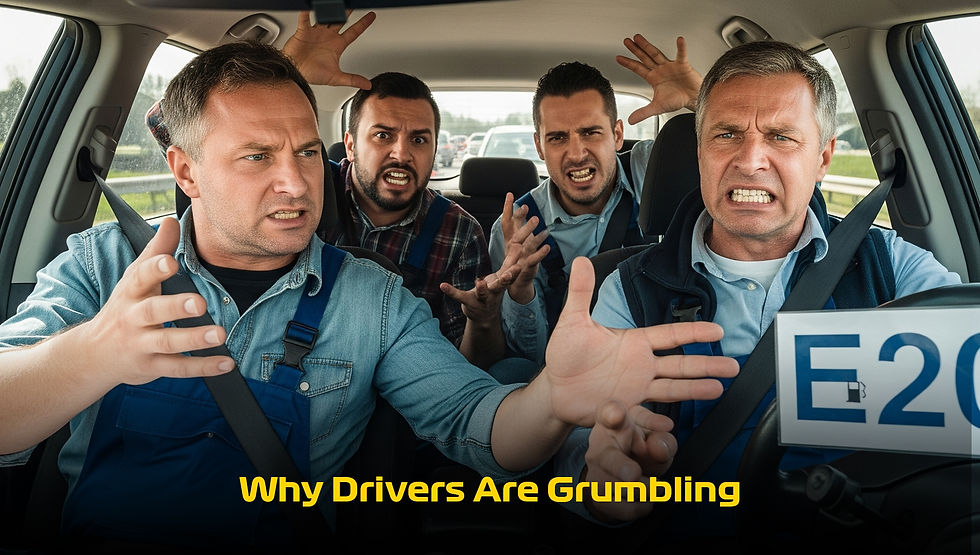Why Other Countries Love Ethanol But Indian Drivers Aren’t Convinced
- Q Po India
- Sep 10
- 3 min read

E20 isn’t news anymore — by now, most Indian drivers know their fuel is no longer pure petrol but a blend. The real question today isn’t what E20 is, but how it’s messing with (or improving) your daily drive.
While the government pops the champagne over foreign exchange savings and cleaner air.
The car owners are left wondering:
Why does my mileage feel lower?
Will my old car survive this cocktail?
And why do other countries get to choose their blend while we don’t?
Let’s dig in.
What Happens When Your Car Drinks E20?

Think of petrol as full-fat milk and ethanol as almond milk. Mix them, and your coffee still tastes fine — but the kick is different.
Mileage Drop: Ethanol has about 30% less energy than petrol. Mix it in, and your car burns a little extra to cover the same distance. That’s a 2–4% dip in mileage on paper, but sometimes worse in traffic.
Cleaner Combustion: On the bright side, ethanol brings oxygen into the mix, making the burn cleaner. Fewer tailpipe emissions, slightly happier environment.
Older Cars Beware: Vehicles made before April 2023 weren’t designed for this blend. Rubber hoses, pumps, and seals may wear out faster — like asking a 90s Walkman to play Spotify.
Practical Example: If your car usually gives 15 kmpl, with E20 you might see ~14.4 kmpl. Over a year (12,000 km), that’s 40–50 extra litres of fuel burnt. Enough for a weekend road trip you now can’t afford.
How Other Countries Handle Their Ethanol Mix:

India isn’t the first to pour ethanol into the tank. The difference is in how others did it:
Brazil: The OG ethanol champion. Cars are flex-fuel, designed to run on anything from E20 to E100. Drivers choose what they want at the pump.
USA: Standard petrol is E10. Flex-fuel cars can sip E15 or even E85. Crucially, pure petrol (E0) is still available for those who want it.
Europe: Sticks to E5 and E10 for balance. Small steps, less drama.
Thailand & Indonesia: Push E20 and E85 but back it up with subsidies and awareness campaigns.
India’s Twist: Most fuel pumps are switching straight to E20, without options. It’s like going to your favorite Chaiwala and finding out he only serves green tea now — like it or not.
Why the Government is Celebrating

* ₹43,000 Crore Saved Every Year: Less crude oil imported.
* Farmers Get Paid: Over ₹1.25 lakh crore already disbursed for ethanol feedstock.
* Cleaner Emissions: Official data shows up to 50% lower carbon monoxide and 30% less CO₂ compared to E10.
Why Drivers Are Grumbling

* Mileage drop eats into savings at the pump.
* Older cars face compatibility risks.
* No blend choices at pumps — just E20.
* Diverting maize and sugarcane to ethanol risks food price hikes.
* Sugarcane farming guzzles water in a country already stressed for groundwater.
If India takes a page from Brazil or the US and offers choices — E10, E20, and pure petrol side by side — the transition would be smoother. Until then, every fill-up is a gamble: am I helping the planet, or just paying for more fuel?
E20 is like that group project partner: looks great on the teacher’s report but leaves you doing extra work. For India, it’s a win — saving money, boosting farmers, and reducing emissions. For car owners, it’s… complicated.
Quick FAQs
Will E20 damage my car?
If it’s made after April 2023, you’re fine. Older models may suffer wear — like feeding strong whiskey to someone used to soft drinks.
Does E20 really cut pollution?
Yes, CO down by 50% and CO₂ by 30% compared to E10. But don’t expect Delhi winters to magically become Switzerland.
Why can’t I find E10 anymore?
Because most pumps are rolling out E20 without offering alternatives. Unlike the US, India didn’t give you a “fuel menu.”
Do other countries force E20?
Nope. They give options. Brazil even lets drivers fill up with 100% ethanol if they want.



Comments